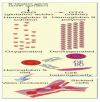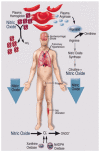Pathological basis of symptoms and crises in sickle cell disorder: implications for counseling and psychotherapy
- PMID: 22184515
- PMCID: PMC3222266
- DOI: 10.4081/hr.2010.e2
Pathological basis of symptoms and crises in sickle cell disorder: implications for counseling and psychotherapy
Abstract
Sickle Cell Disorder (SCD) is a congenital hemoglobinopathy. There is little in literature regarding the psychological variables affecting individuals living with SCD and all of the significant people around them. There are also limited numbers of trained clinical psychologists and genetic counselors to cater for the psychotherapeutic needs of individuals living with SCD. Even among those who have been trained, only a few might have fully grasped the complexities of the disease pathology.Early understanding of its pathological nature, sources, types, complications, pathophysiological basis, and clinical severity of symptoms among clinical psychologists, genetic counselors and psychotherapists, as well as general medical practitioners, could guide them in providing holistic care for dealing with and reducing pain among individuals living with SCD. It could allow risk-based counseling for families and individuals. It could also justify the early use of disease-modifying or curative interventions, such as hydroxyurea (HU), chronic transfusions (CTs), or stem-cell transplantation (SCT) by general medical practitioners. Hence, the need for this paper on the pathophysiology of SCD.
Keywords: counseling and psychotherapy.; implications; pathology; sickle cell disorder.
Figures











Similar articles
-
Impact of Hydroxyurea Therapy in Reducing Pain Crises, Hospital Admissions, and Length of Stay Among Sickle Cell Patients in the Eastern Region of Saudi Arabia.Cureus. 2022 Nov 15;14(11):e31527. doi: 10.7759/cureus.31527. eCollection 2022 Nov. Cureus. 2022. PMID: 36540486 Free PMC article.
-
Sickle Cell Disease: A Review.JAMA. 2022 Jul 5;328(1):57-68. doi: 10.1001/jama.2022.10233. JAMA. 2022. PMID: 35788790 Review.
-
Management of sickle cell disease: summary of the 2014 evidence-based report by expert panel members.JAMA. 2014 Sep 10;312(10):1033-48. doi: 10.1001/jama.2014.10517. JAMA. 2014. PMID: 25203083 Review.
-
New Therapeutic Options for the Treatment of Sickle Cell Disease.Mediterr J Hematol Infect Dis. 2019 Jan 1;11(1):e2019002. doi: 10.4084/MJHID.2019.002. eCollection 2019. Mediterr J Hematol Infect Dis. 2019. PMID: 30671208 Free PMC article. Review.
-
Clinical outcomes of COVID-19 in patients with sickle cell disease and sickle cell trait: A critical appraisal of the literature.Blood Rev. 2022 May;53:100911. doi: 10.1016/j.blre.2021.100911. Epub 2021 Nov 20. Blood Rev. 2022. PMID: 34838342 Free PMC article. Review.
Cited by
-
The Key Role of GSH in Keeping the Redox Balance in Mammalian Cells: Mechanisms and Significance of GSH in Detoxification via Formation of Conjugates.Antioxidants (Basel). 2023 Nov 1;12(11):1953. doi: 10.3390/antiox12111953. Antioxidants (Basel). 2023. PMID: 38001806 Free PMC article. Review.
-
Red cell distribution width as a surrogate marker of haemoglobinopathies in western Kenya.Afr J Lab Med. 2022 Apr 29;11(1):1644. doi: 10.4102/ajlm.v11i1.1644. eCollection 2022. Afr J Lab Med. 2022. PMID: 35547332 Free PMC article.
-
Gender-Related Differences in Sickle Cell Disease in a Pediatric Cohort: A Single-Center Retrospective Study.Front Mol Biosci. 2019 Dec 5;6:140. doi: 10.3389/fmolb.2019.00140. eCollection 2019. Front Mol Biosci. 2019. PMID: 31867340 Free PMC article.
-
Isolation and Characterisation of Quercitrin as a Potent Anti-Sickle Cell Anaemia Agent from Alchornea cordifolia.J Clin Med. 2022 Apr 13;11(8):2177. doi: 10.3390/jcm11082177. J Clin Med. 2022. PMID: 35456270 Free PMC article.
-
An Erythropoietin-Independent Mechanism of Erythrocytic Precursor Proliferation Underlies Hypoxia Tolerance in Sea Nomads.Front Physiol. 2022 Jan 27;12:760851. doi: 10.3389/fphys.2021.760851. eCollection 2021. Front Physiol. 2022. PMID: 35177992 Free PMC article.
References
-
- Embury SH, Hebbel RP, Mohandas N, Steinberg MH, editors. Basic Principles and Clinical Picture. New York: Raven Press; 1994. Sickle cell disease; pp. 311–311.
-
- Serjeant GR. 3rd ed. New York: Oxford University Press; 2001. Sickle cell disease.
-
- Ballas SK. Progress in Pain Research and Management. Vol. 11. Seattle, WA: IASP Press; 1998. Sickle Cell Pain.
-
- Benjamin LJ, Dampier CD, Jacox A, et al. American Pain Society Clinical Practice Guidelines Series No. 1. Glenview, IL: 1999. Guideline for the Management of Acute and Chronic Pain in Sickle cell disease.
-
- Benjamin LJ. Nature and treatment of the acute painful episode in sickle cell disease. In: Steinberg MH, et al., editors. Disorders of Hemoglobin: Genetics, Pathophysiology, and Clinical Management. Cambridge: 2001. pp. 671–710.
LinkOut - more resources
Full Text Sources
Research Materials

